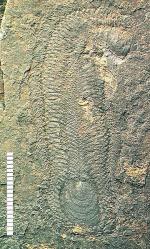 Halkieria evangelista: from the Lower Cambrian. Image from WikiCommons For the vast majority of Earth's history, there existed only single-celled organisms. During the Cryogenian Period, 850-630 Ma (millions of years ago), the Earth experienced a series of deep glaciations, sometimes referred to as "Snowball Earth." As the ice waned, Ediacaran organisms made their first appearance. Ediacarans were large, strange, and probably sessile creatures of unknown affinity who lived between 630-542 Ma.
Halkieria evangelista: from the Lower Cambrian. Image from WikiCommons For the vast majority of Earth's history, there existed only single-celled organisms. During the Cryogenian Period, 850-630 Ma (millions of years ago), the Earth experienced a series of deep glaciations, sometimes referred to as "Snowball Earth." As the ice waned, Ediacaran organisms made their first appearance. Ediacarans were large, strange, and probably sessile creatures of unknown affinity who lived between 630-542 Ma. At 542.0 1 Ma, life on Earth radically changed, with the appearance of Trichophycus pedum, a mud burrower with complex movement. The first appearance of Trichophycus pedum marks the beginning of the Cambrian Period (542-488 Ma). From 542 Ma, and especially during the middle Cambrian, animal diversity rapidly increased. This is referred to as the Cambrian Explosion or the Cambrian Radiation.
